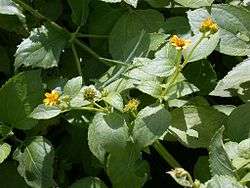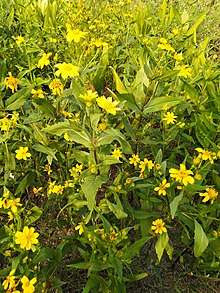Melanthera biflora
Melanthera biflora,[4] also known as sea daisy, beach daisy and sea ox-eye, (Hindi: Bhringaraaja; Malay: Serunai laut, Pokok serunai; Fijian: Kovekove, Sekava; Maldivian: Mirihi; Samoan: Ateate; Thai: เบญจมาศน้ำเค็ม or ผักคราดทะเล;[5] Tongan: Ate), is a species of flowering plant in the aster family. It is a scandent, rough-looking and fast-growing plant with a wide distribution.
| Melanthera biflora | |
|---|---|
 | |
| Scientific classification | |
| Kingdom: | |
| (unranked): | |
| (unranked): | |
| (unranked): | |
| Order: | |
| Family: | |
| Subfamily: | |
| Tribe: | |
| Genus: | |
| Species: | M. biflora |
| Binomial name | |
| Melanthera biflora (L.) Wild. | |
| Synonyms | |
| |
Distribution
Melanthera biflora is a moderately salt-tolerant plant found in the tropical belt of the Indo-Pacific region, including China, the Indian Subcontinent, Southeast Asia, Queensland, and islands of the Pacific such as Fiji, Niue, Tonga, Samoa and the Cook Islands.
It is found commonly in islands and in coastal areas, although it sometimes occurs inland in neglected and unmanaged plantations as well as in ruderal environments.[6]
Together with Portulaca oleracea, Ipomoea pes-caprae and Digitaria ciliaris, Melanthera biflora is usually one of the first species colonizing degraded or altered environments in tropical zones of the planet.[7]
Description
Melanthera biflora is a hardy and somewhat woody, sprawling perennial herb or subshrub. Stems are elongate and branched; they can reach up to 2 m but will bend after reaching a certain height.

It can scramble and straggle over the ground or climb leaning on other plants for support. The leaves are ovate, shortly tapering at the base. It produces small yellow flower heads with a diameter of about 8–10 mm. The fruits form a dense head.[8]
General appearance of the shrub. |
 Flowering shrub from Tonga growing along the seashore. |
Uses
Despite the rough appearance of the plant, the leaves are edible.[9][10] In Malaysian cuisine the shoots are eaten cooked as a leaf vegetable and in Langkawi they are eaten raw with chilli and sambal shrimp paste. Leaves also have traditional medicinal uses as poultice or as decoction.[11][12]
Melanthera biflora has traditionally been used as a medicinal plant in many cultures, including in Marovo in the Solomon Islands.[13][14] Leaves are especially valued against stomachache.[10] In Fiji the leaves are used to treat acne.[11] Root extracts have anthelmintic properties[15] and flowers can be used as a purgative.[14]
This plant is also used as fodder for rabbits.
See also
References
- Decaisne, Joseph. 1834. Nouvelles annales du Muséum d'histoire naturelle 3: 414-415 descriptions in Latin, commentary in French
- Tropicos, Wollastonia DC. ex Decne.
- Flora of China Vol. 20-21 Page 871 孪花菊属 luan hua ju shu Wollastonia Candolle ex Decaisne, Nouv. Ann. Mus. Hist. Nat. 3: 414. 1834.
- 'Melanthera biflora' The Plant list
- Mangrove forest: เบญจมาศน้ำเค็ม
- Response of Melanthera biflora to Salinity and Water Stress
- Heatwole, H., Done, T., Cameron, E. Community Ecology of a Coral Cay, A Study of One-Tree Island, Great Barrier Reef, Australia. Series: Monographiae Biologicae, Vol. 43, p. 102
- Melanthera biflora (L.) Wild - Atlas of Living Australia
- Ecoport
- Melanthera biflora - Useful Tropical Plants
- Globinmed - Wedelia biflora
- Rules for Maldivian Trading Ships Travelling Abroad (1925)
- Pawley, Andrew; Osmond, Meredith (eds). 2008. The lexicon of Proto Oceanic: The culture and environment of ancestral Oceanic society. Volume 3: Plants. Pacific Linguistics 599. Canberra: Pacific Linguistics, Australian National University.
- "Hagonoi / Wedelia Biflora". Philippine Medicinal Plants. Retrieved 2008-04-07.
- Cheryll Williams, Medicinal Plants in Australia Volume 4: An Antipodean Apothecary, Volume 4, p. 58
External links
| Wikispecies has information related to Melanthera biflora |
